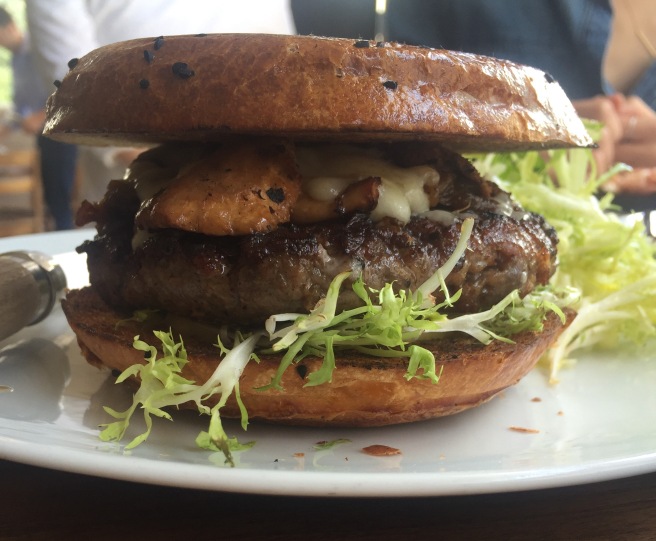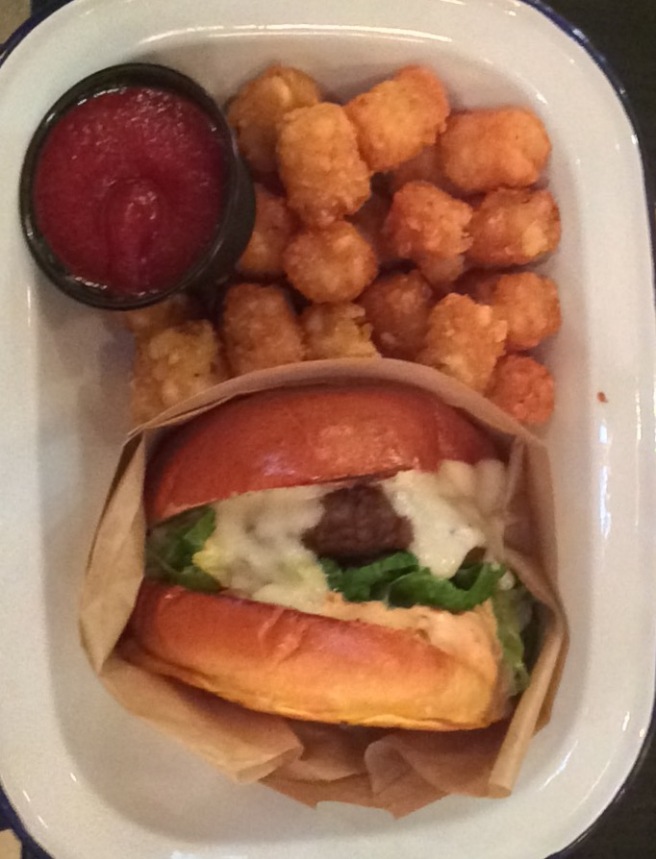The Place

Dudley Market
9 Dudley Avenue
Venice, CA 90291
Reservations: 424.744.8060
Bar: Beer and wine only
Sunday was a difficult day. Not in the sense that it was a strenuous day. Just because it reminded me of the tortured relationship I maintain with Venice.
When I lived on the East Coast, Venice pretty nearly captured everything I missed about home. The sun’s rays so bright you swear you can see resplendent gold blades against the implausibly blue sky. The heat of those rays on your skin tempered by the ocean breeze. The way that breeze that picks up and swirls stray grains of sand. The way that sand manages to get between your toes, even when you’ve worn shoes. The seemingly anti-gravitational lean of palm trees in the briny air. All the beautiful people walking down sidewalks peering into the windows of high-end boutiques, passing through the aromatic clouds drifting up and over from food trucks idling on the blacktop.
And speaking of food, Venice has long been a culinary center in Los Angeles. The Tasting Kitchen and Gjelina, by now, are old news (but still newsworthy). More recently, veteran culinary icons (Josiah Citrin) and young upstarts (Top Chef winner Nyesha Arrington) have laid down roots there as well.
The TL;DR version of all that is that there’s a lot to love in Venice: weather, sunshine, the beach, and delicious food. For a time, I was dead-set on living in Venice upon returning to Los Angeles.
After that drooling paean, what, you ask, makes my relationship with Venice “tortured?”
Because, before eating a quite-good brunch at the charming Dudley Market, you have to proceed through a gauntlet of challenges that Venice lays before all those who come to share in its beachside bounty. First, you have to park. Basically, that amounts to crawling through labyrinthine side streets and alleys, doing your damndest to not commit a tort against one of the actually psychotic cyclists swerving in and out of your path. As you do, you’ll be flanked on one side by side streets running perpendicular to you, all packed with cars, and on the other side by totally vacant beachside lots charging a cash-only $20 flat rate – a rate that frugality and mulish pride won’t let you pay.
Then you get out of your car (after displaying an embarrassing lack of parallel parking acumen for a crowd of dead-eyed, unwashed, and dreadlocked white people), and you’re forced to really see Venice. Sun-bronzed hippies, carelessly half-naked, leaning against the walls of grubby and overpriced apartment buildings, weirdly unaffected by the strange funk the beach breeze carries from nearby dumpsters. Hungover bros speeding down those alleys in their fathers’ leased Teslas. Bottle blondes in garish $600 sunglasses from last season, oozing a petulant, practiced apathy through bar-battered bangs. Tourists, drenched in sweat and marveling at the spectacle of all these disparate demographics coexisting seamlessly. And even if you’re a native, you’ll find yourself marveling at it too. It’s staggering, stereotypically Californian, and a little gross.
But Venice is like an old friend. She may occasionally annoy or disgust, but it doesn’t take much to remind you of why you love her and are lucky to have her around. As pissed as I was about parking, and about feeling like a millennial Frogger dodging $100,000 electric cars, it all melted away when I felt that breeze come in off the Pacific . Any residual impatience was obliterated when I took the first sip of Dudley Market’s stellar espresso milkshake with the beach at my back.
I didn’t go for the milkshake, of course. Kelsey and I stopped in at Jesse Barber’s new spot to try the Burger Diane.
The Order: Burger Diane (beef/pork patty, gruyere, melted onions, greens, dijon, mushroom, and pickles on sourdough hybrid).
You might ask yourself, “Why is it called a Burger Diane?” It’s likely a play on steak Diane, which is a filet mignon in a mushroom and Dijon mustard-based sauce (there’s more to it than that, like heavy cream and brandy or something, I think; but this isn’t Delmonico’s and I’m not Emeril Lagasse).
The Price: $16 (before tax)
The Burger
Jesse Barber worked at Barnyard before, and it shows. Dudley Market emphasizes the use of high quality, local, seasonal ingredients above haute-cuisine technique. The espresso milkshake features housemade ice cream, which gets its high protein content from the biodynamic duck eggs (from Moorpark) they use to make it. The greens that flanked our burger (some also made their way onto it, actually) were obsessively fresh, drizzled only in lemon juice and oil. The bacon is from a pig that was butchered less than a week ago in-shop. It’s all very L.A.
The burger is built around a patty that is about 60% beef and 40% bacon. It’s cooked just barely on the rare side of medium (there’s no pink). My worry was that the beef would be overcooked to ensure the pork was cooked through, which would give rise to a dry patty with very little personality on the front end, with pork fat and salt dominating the finish.
My worries were misplaced. The beef was cooked through but still juicy, and the pork was subtle, adding salty complexity without overwhelming things. I did not leave Dudley Market convinced that the hybrid patty is a better approach than just cooking an all-beef patty medium rare and putting bacon on top of it, but I am convinced that I was wrong to think you can’t build a good burger around a hybrid patty. You can. Barber has.
The bun is what our server called a “sourdough hybrid,” grilled and pressed into flat discs, dusted with poppy seeds and salt flakes. The crust is buttery and crisp, while the inside maintains the unmistakable just-dry-enough sponginess of sourdough.
The highlight of this burger, though – even more than the estimable patty – was the interplay between the gruyere cheese and the mushrooms. The gruyere is sweet and nutty, tangling nicely with meaty, bold mushroom. The pairing is formidable, and it hits hard early. Less than halfway through the first bite, these two ingredients alone make it clear that this burger is not for the faint of heart.
The cheese and mushrooms are an earthy, complex overture to the surprisingly graceful and tasteful mash-up of beef and bacon that follows. Just as the savor reaches its climax – at the moment when it’s all about to get a bit too “forest floor and barnyard gore” for good taste – the pickles emerge as if out of nowhere, bright but not too briny, offering a little kick of acid to clean everything up, the ideal prelude to the sweet, mustardy finish.
Only the melted onions, cooked even past the point of caramelized sweetness, seem superfluous; they lurk like emo kids at lunch, hidden from the rest of the flavor profile. That’s a disappointing but hardly damning flaw in an otherwise superb preparation, as well-balanced as it is creative.
I guess Dudley Market is kind of a microcosm of Venice itself: There are aggravations – notably, slow service and steep prices – but on balance, there are more reasons to return than to stay away (but order with care, as the menu decidedly is not uniformly inspiring; the speck with burrata and balsamic was simple and arresting despite the absence of the advertised poached apple, but the crab louie was little more than an incoherent jumble of pleasant things).
Yes, you’ll need to budget a bit of time for your meal; this place isn’t exactly run with German efficiency (though if you have an enchanting companion and an espresso milkshake to keep you company while you wait, you won’t mind the wait so much). And yes, the burger specifically – and Dudley Market more generally – is as overpriced as the surrounding real estate. But unlike the surrounding real estate, there’s more to Dudley Market than a nice view and convenient beach access. So stop in and try this burger. Consider it one more reminder why you love Venice in spite of the fact that it’s so…Venice.
The Ratings
Flavor: 9.20 / 10.00
Freshness/Quality: 10.00 / 10.00
Value: 8.00 / 10.00
Efficiency: 8.00 / 10.00
Creativity/Style: 9.40 / 10.00
Bun: 9.20 / 10.00
Patty: 9.30 / 10.00
Toppings: 8.30 / 10.00
Sauce: 8.50 / 10.00
Balance: 9.00 / 10.00
Total: 88.90 / 100.00

 Winsome is not on Sunset Boulevard. Head west down Sunset (away from Downtown) and as you pass Beaudry, you’ll see the Holy Community Church on your right. Beyond that, you’ll see a new apartment building made of white stone and glass. Just past the church, make a right on to White Knoll Drive. That’s where Winsome is, in the ground floor of the aforementioned stone and glass building. Just a public service announcement, lest you wind up wandering aimless and befuddled down Sunset like Kelsey, Erin, and I did (that is, until finally we gave up and called the restaurant to whimper a desperate request for directions).
Winsome is not on Sunset Boulevard. Head west down Sunset (away from Downtown) and as you pass Beaudry, you’ll see the Holy Community Church on your right. Beyond that, you’ll see a new apartment building made of white stone and glass. Just past the church, make a right on to White Knoll Drive. That’s where Winsome is, in the ground floor of the aforementioned stone and glass building. Just a public service announcement, lest you wind up wandering aimless and befuddled down Sunset like Kelsey, Erin, and I did (that is, until finally we gave up and called the restaurant to whimper a desperate request for directions).

 Santa Monica on a summer weekend truly is an incredible thing. The beautiful, sun-bronzed masses take to the streets in outfits carefully chosen to reveal the fruits of a winter spent in pilates classes, or of the paleo diet, or of thousands of dollars in Equinox membership fees or CrossFit classes, or of the latest juice cleanse.
Santa Monica on a summer weekend truly is an incredible thing. The beautiful, sun-bronzed masses take to the streets in outfits carefully chosen to reveal the fruits of a winter spent in pilates classes, or of the paleo diet, or of thousands of dollars in Equinox membership fees or CrossFit classes, or of the latest juice cleanse.



